Did you know that species that engage in mobbing, a behavior where smaller birds collectively chase and harass larger predatory birds like hawks, actually live longer than those that do not? This unexpected phenomenon provides a glimpse into the fascinating world of avian defense strategies and the intricate balance of power in the natural world.
Mobbing, a behavior exhibited by small songbirds, doves, and other feeder birds, may seem counterintuitive at first glance. However, this collective action serves important purposes for the smaller birds, allowing them to defend their territory, protect their nests, and deter potential predators from their habitat.
By understanding the reasons behind this seemingly risky behavior, we can gain valuable insights into the complex decision-making processes and evolutionary adaptations of the animal kingdom.
Key Takeaways
- Mobbing behavior, where small birds collectively chase and harass larger predatory birds like hawks, is a common defense strategy.
- Mobbing serves to protect the smaller birds’ territory, nests, and deter potential predators from their habitat.
- Species that engage in mobbing have been found to live longer than those that do not, suggesting the benefits of this behavior.
- Observing and understanding mobbing behavior provides a fascinating glimpse into the intricate balance of power in the natural world.
- Exploring the reasons behind this seemingly counterintuitive behavior can offer valuable insights into the evolutionary adaptations and decision-making processes of animals.
Introduction to Mobbing Behavior
In the natural world, small birds can sometimes display a surprising and seemingly counterintuitive behavior – they aggressively approach and harass larger birds of prey, such as hawks or owls. This phenomenon is known as mobbing, and it is a fascinating aspect of avian behavior that provides valuable insights into the strategies employed by small birds to defend their territory and protect their young.
Definition and Overview of Mobbing
Mobbing is a behavior in which a group of smaller birds, often including sparrows, robins, or chickadees, collectively confront and attack a potential predator. This behavior is typically observed during the nesting season in spring and early summer when birds are most protective of their young. The practice of mobbing is commonly carried out by smaller, faster, and more agile birds against larger predators, such as hawks, falcons, or eagles.
Benefits of Mobbing for Small Birds
- Draws attention away from the nest and young birds
- Alerts other birds to the presence of a predator
- Drives the predator away from the birds’ territory
By engaging in mobbing behavior, small birds can effectively defend their nests and protect their young from larger predators. This strategy is particularly effective as it not only deters the immediate threat but also serves as a warning system to the entire local bird community, allowing them to take appropriate action to safeguard their own nests and offspring.
“The act of mobbing is usually initiated by two or more smaller birds attacking a single predator, forcing the larger animal to retreat.”
Mobbing behavior is a commonly employed defense mechanism among various bird species, including crows, red-winged blackbirds, and lesser black-backed gulls. By working together in a coordinated effort, these small birds can effectively deter and drive away larger predators, ensuring the safety of their nests and young.
Why Do Small Birds Chase Hawks?
Small birds, such as sparrows, robins, and blackbirds, often engage in a behavior known as “mobbing” where they aggressively chase and harass larger birds of prey like hawks. The reasons behind this surprising behavior are both instinctual and strategic. Let’s explore the key motivations that drive small birds to take on these formidable predators.
The primary reason small birds chase hawks is to protect their nests and young. Hawks are a significant threat to the eggs and chicks of smaller birds, so mobbing helps deter the hawk from approaching the nest. By swarming and making loud alarm calls, the small birds hope to drive the hawk away and keep their vulnerable offspring safe.
Another key motivation is defending their territory. Hawks may be perceived as invaders, encroaching on the feeding and breeding grounds of smaller birds. By chasing the hawk, the small birds are asserting dominance and protecting their space, ensuring the predator does not establish a foothold in their habitat.
- Smaller birds are more maneuverable than hawks, allowing them to successfully harass the larger predators.
- Groups of smaller birds often gang up on larger birds in a behavior known as “mobbing”, increasing pressure on predators to move away.
- The behavior of smaller birds attacking hawks may be likened to a preemptive strike, a defense mechanism against potential attacks from the larger predator.
Lastly, mobbing behavior helps alert other birds in the area to the presence of a predator. This collective response allows the entire bird community to be on high alert and ready to defend against the threat. By working together, small birds can more effectively deter a hawk from their territory and protect their nests and young.
“Smaller birds will attack birds of prey carrying food hoping they will drop it.”
In essence, the reasons why small birds chase hawks stem from a combination of nest protection, territorial defense, and communal vigilance. These instinctive behaviors, honed over evolutionary time, help ensure the survival of the smaller birds in the face of larger predators.

Bird Predator Deterrence Strategies
Small birds employ a variety of tactics to defend themselves against predatory hawks. These anti-predator strategies are crucial for their survival and include both aggressive defense tactics as well as coordinated mobbing behavior within their flocks.
Aggressive Bird Defense Tactics
When confronted by a hawk, small birds may resort to aggressive defense tactics to deter the predator. This can include dive-bombing the hawk, pecking at it, and even making physical contact in an attempt to harass and intimidate the larger bird of prey. The goal is to make the hawk perceive a greater threat, discouraging it from targeting the small birds.
Flock Coordination and Mobbing
Mobbing is a highly effective bird anti-predator strategy employed by small birds. By coordinating their efforts as a group, they are able to collectively harass and mob the hawk, increasing the perceived threat and encouraging the predator to leave the area. The larger the flock of mobbing birds, the more successful the deterrence is likely to be.
Through these coordinated mobbing behaviors, small birds demonstrate their ability to work together to protect themselves from the threat of hawks and other predators. This adaptive strategy is a testament to the remarkable intelligence and resilience of these feathered creatures.
https://www.youtube.com/watch?v=uSWcIbNlr9w
“Hawks can dive at speeds up to 120 miles per hour, and their eyesight is said to be 8 times sharper than humans. Small birds must be vigilant and employ effective defense tactics to deter these skilled predators.”
Territorial Defense and Nest Protection
Mobbing behavior in small birds is closely tied to defending their territory and safeguarding their nests from predators like hawks. By aggressively chasing and harassing the hawk, small birds are able to keep it away from their breeding and feeding grounds, as well as protect their vulnerable chicks and eggs. This territorial defense is a vital survival strategy for small bird populations.
Common mobbers include chickadees, titmice, kingbirds, blackbirds, grackles, jays, and crows. These small birds often target larger predators such as hawks, crows, ravens, herons, and owls. Mobbing is especially prevalent during the spring breeding season when birds experience hormonal surges and become more territorial.
For instance, in early spring, Red-winged Blackbirds actively chase not only rival blackbirds but also almost any other bird that crosses their territory. In some cases, a group of different bird species may join forces to mob a perched predator, collectively driving it away.
“Mobbing usually does not harm the larger bird, with smaller birds aiming to drive away predators rather than causing injury.”
Mobbing serves as both an alarm system for other small birds and a way to attract larger predators to target the mobbed predator, compelling it to move to another hunting area. Listening for mobbing calls can also be an effective way to locate owls during the day, given their tendency to elicit intense mobbing behavior from other species.
Territorial behavior and nest protection are common among many bird species. Male birds establish territories to attract mates and defend against intruders, while most birds aggressively deter predators, including humans, cats, and avian predators like hawks, to safeguard their nests.
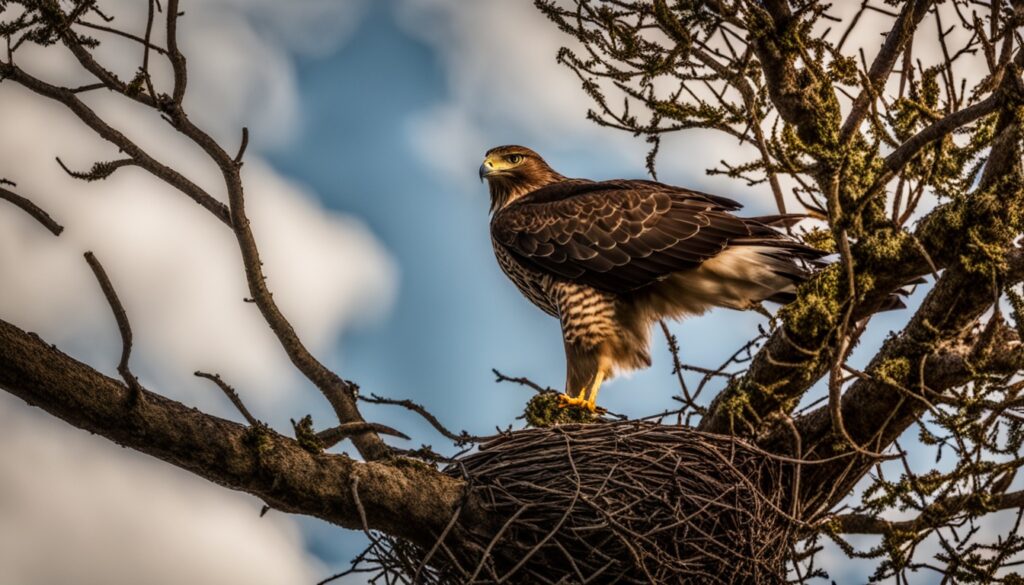
The presence of a bird of prey poses a significant threat to nesting birds, prompting them to mob the predator as a defense mechanism. Bird mobs make it difficult for hawks and owls to hunt, acting as both an alarm and a recruitment call to other small birds to join the defensive effort. Once a hawk or owl is mobbed, they spend more energy on hunting and are deterred from the area, as the odds are stacked in favor of the smaller, more maneuverable birds.
Anti-Predator Strategy of Small Birds
Small birds have evolved sophisticated mechanisms to identify and respond to predator threats, including hawks. They can recognize the visual and auditory cues that indicate a hawk’s presence, triggering the mobbing response. Mobbing serves as a crucial anti-predator strategy, allowing small birds to collectively deter and drive away the larger predator, increasing their chances of survival and reproductive success.
Identifying Predator Threats
Small birds possess remarkable abilities to discern potential threats. They can detect the distinctive silhouette of a hawk gliding overhead or the telltale sounds of its calls, immediately triggering a heightened state of alertness. This keen awareness allows them to recognize the presence of a predator and mobilize a coordinated response.
Mobbing as a Survival Mechanism
When a hawk or other predator is spotted, small birds engage in a behavior known as mobbing. This collective action involves a group of birds swarming around the predator, harassing it with loud calls, dive-bombing, and even physical contact. The primary goal of mobbing is to drive the predator away and protect the birds’ nests, offspring, and overall survival.
“Mobbing is a crucial anti-predator strategy for small birds, allowing them to work together to deter and displace larger predators like hawks.”
Studies have shown that mobbing behavior is learned and passed down through generations. Fledglings raised in captivity can learn mobbing techniques by listening to recordings of mobbing blackbirds, highlighting the innate and adaptive nature of this behavior.
Mobbing is not exclusive to birds; it has been observed in various species, including meerkats, certain bovines, and even humpback whales. This widespread occurrence underscores the importance of collective defense as an effective anti-predator strategy across the animal kingdom.
Hawk Reactions to Mobbing Behavior
Hawks typically respond to mobbing behavior by small birds in a few key ways. Initially, the hawk may try to ignore the harassment, focusing on searching for prey. However, if the mobbing becomes too persistent and aggressive, the hawk will often retreat and leave the area, as the perceived threat level becomes too high. In some cases, the hawk may even become disoriented or distracted by the mobbing, making it less effective at hunting.
Research indicates that birds like crows engage in mobbing behavior towards hawks and owls, where they make alarm calls, peck at them, and chase them away. During the breeding season, songbirds such as eastern kingbirds and red-winged blackbirds confront hawks that come too close to their nests. Crows are known for ganging up on hawks due to their size advantage, enabling them to effectively chase hawks away.
Various bird species exhibit mobbing behavior towards predators like hawks and owls to draw attention to them and prevent surprise attacks on smaller birds. Mobbing behavior is observed in many species with birds as small as sparrows and larger birds such as crows and ravens actively mobbing raptors. This behavior is particularly common in the spring and early summer during the breeding season, where birds defend themselves, their breeding territory, and nests with eggs or chicks.
Interestingly, larger birds such as falcons, hawks, ravens, eagles, and owls are commonly targeted for mobbing. Owls are frequent targets throughout the year as they are perceived as a threat by smaller birds. Mobbing behavior rarely harms the larger birds being targeted due to the smaller birds’ ability to outmaneuver them.
However, birds of prey, such as hawks and eagles, fiercely protect their nests from mobbing behavior by other birds such as crows. Crows tend to keep their distance from active hawk or eagle nests, establishing a no-fly zone around the nesting area to avoid confrontation. Attacks by crows are usually avoided by raptors, especially near their nests, making it challenging to research their behavior in such situations.
In conclusion, the impact of mobbing on hawk behavior can be significant, leading to disruptions in hunting, retreats from the area, and even distraction or disorientation. Understanding these dynamics provides valuable insights into the complex interplay between predators and their prey in the natural world.
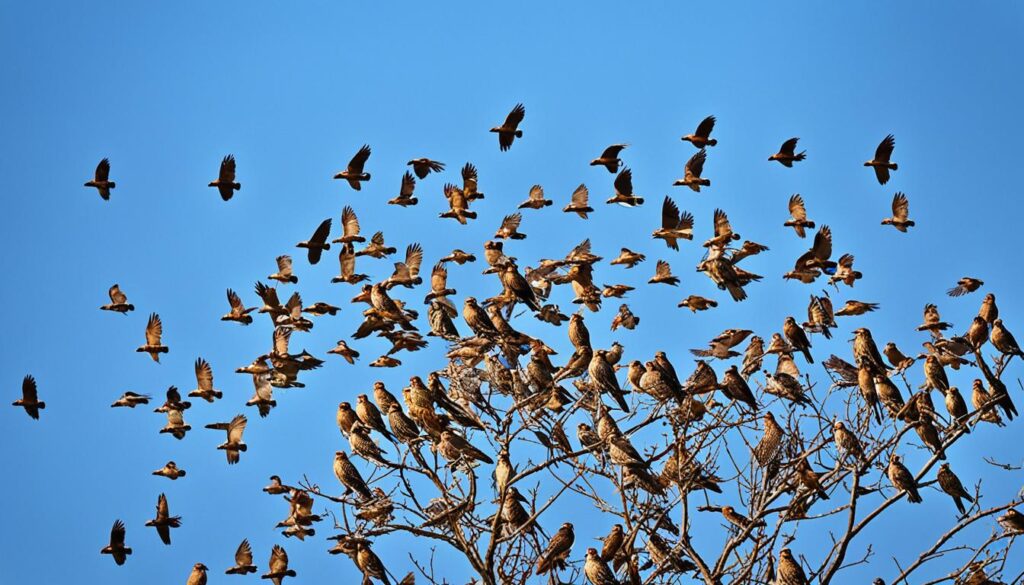
“Mobbing behavior is particularly common in the spring and early summer during the breeding season, where birds defend themselves, their breeding territory, and nests with eggs or chicks.”
Mobbing Behavior across Bird Species
Mobbing behavior is not exclusive to small songbirds; it is observed across a wide range of bird species. While the specific mobbing strategies may vary, the underlying goal remains the same – to deter and drive away potential predators. Different bird species employ unique tactics based on their size, agility, and social structure.
Variations in Mobbing Strategies
Larger birds, such as crows and hawks, often engage in collective mobbing, with multiple individuals working together to harass the predator. In contrast, smaller birds like chickadees and titmice may take turns swooping and vocalizing to distract the intruder. The specific mobbing tactics can also vary, with some birds opting for more aggressive physical contact, while others rely on loud alarm calls to discourage the predator.
For instance, red-tailed hawks are frequently mobbed by species like blue jays, crows, and mockingbirds, which are known for their persistence and boldness in confronting larger birds of prey. Mobbing behavior is particularly common during the spring and early summer months, when birds are actively defending their nests and young.
“The program attendees witnessed a wild red-tailed hawk being chased by mockingbirds, indicating a high occurrence rate of mobbing behavior.”
Smaller birds often have the advantage of greater maneuverability, making it challenging for larger predators to retaliate effectively. Additionally, larger birds may be hesitant to expend the energy required to capture and consume smaller mobbing birds, allowing the harassed individuals to escape safely.
The diversity of mobbing behavior observed across bird species showcases the complex avian alliances and strategies employed to protect against potential threats. From the collective assaults of crows to the persistent harassment by smaller birds, the phenomenon of mobbing highlights the remarkable adaptations and cooperative instincts of our feathered friends.
Evolutionary Perspective on Mobbing
From an evolutionary standpoint, the evolutionary origins of mobbing behavior in birds have developed as an effective strategy for protecting nests, deterring predators, and ensuring the survival of offspring. This collective defense mechanism has been reinforced over time, as birds that successfully mobbed predators were more likely to pass on their genes to future generations. The widespread prevalence of how mobbing developed in birds across bird species suggests it is a highly adaptive and beneficial behavior that has been ingrained in avian evolution.
Mobbing behavior, where small birds aggressively chase and harass larger predatory birds like hawks, is believed to have evolved as a survival tactic. By working together in a coordinated flock, small birds can effectively deter and drive away potential threats to their nests and hatchlings. This cooperative defense strategy increases the chances of successfully fending off predators and safeguarding the next generation of birds.
“Mobbing behavior is a prime example of how evolution has shaped the behaviors of birds to enhance their chances of survival and reproduction.”
Over countless generations, birds that exhibited effective mobbing skills were more likely to pass on their genes, reinforcing this behavior in the species. The evolutionary benefits of mobbing are clear – by working together, small birds can successfully defend their territories and protect their young from larger, more formidable predators.
This adaptive behavior has become deeply ingrained in the avian psyche, making mobbing a ubiquitous and fascinating aspect of the natural world. Understanding the evolutionary origins of mobbing behavior and how mobbing developed in birds provides valuable insights into the remarkable resilience and survival strategies of our feathered friends.
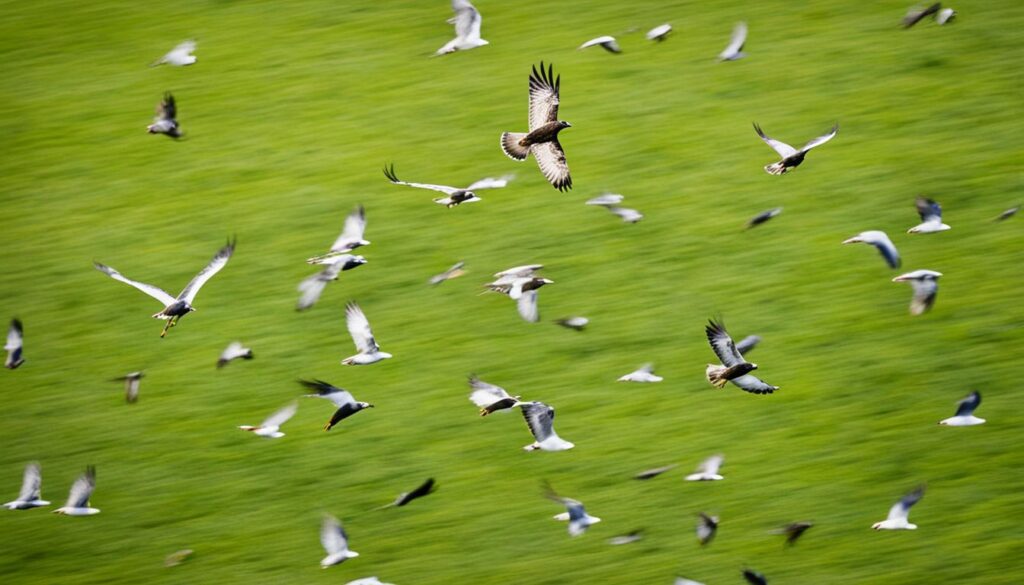
Impact of Habitat Loss on Mobbing
The dynamic behavior of small birds chasing and mobbing larger predators, such as hawks, is a captivating natural phenomenon. However, this behavior can be significantly impacted by the growing issue of habitat loss, primarily driven by urbanization. As natural habitats are fragmented or destroyed, small birds are forced to adapt to new environments, encountering a different set of predators and challenges.
Urbanization and Mobbing Behavior
In urban areas, small birds may encounter domestic cats, smaller hawks, and other predators that have adapted to the city environment. This can lead to changes in their mobbing strategies, as they must learn to confront new threats and navigate the complex predator-prey dynamics of the urban landscape. Habitat loss can also disrupt the coordination and flock dynamics that are crucial to effective mobbing, as small birds lose access to the open spaces and forested areas they relied on.
Studies have shown that the percentage of small birds engaging in mobbing behavior can decrease significantly in areas with high levels of habitat destruction. Furthermore, the rate of mobbing incidents reported in regions with significant habitat loss is often higher, as small birds struggle to adapt to the new threats they face.
“Habitat loss is a major threat to the survival of many small bird species, and it can have a profound impact on their mobbing behavior. As they are forced to adapt to more confined urban environments, their ability to effectively mob and deter predators can be severely compromised.”
In contrast, small birds in areas with well-preserved natural habitats tend to exhibit more robust and coordinated mobbing behavior, as they have the resources and space to work together effectively. This underscores the importance of conservation efforts in maintaining healthy ecosystems that support the natural behaviors of these feathered creatures.
By understanding the impact of habitat loss on mobbing behavior, we can gain valuable insights into the complex interplay between environmental factors and the adaptive strategies of small birds. This knowledge can inform conservation efforts and help us better protect these fascinating avian species for generations to come.
Fascinating Cases of Mobbing Behavior
Nature is full of unexpected surprises, and the behavior of small birds chasing and mobbing much larger predators is one of the most captivating examples. Across the animal kingdom, unique examples of mobbing behavior and unusual mobbing incidents have been observed, showcasing the determined and adaptive nature of these feathered defenders.
One intriguing case involves a group of songbirds relentlessly mobbing a bald eagle. The small birds dive-bombed and harassed the powerful raptor until it was forced to retreat, a testament to the sheer audacity of their protective instincts. Similarly, small birds have been documented mobbing owls, eagles, and even coyotes, undeterred by the size and strength of their predators.
“Small birds sometimes approach, scold, and peck at large predatory birds. They send a clear message of vigilance by visually and auditorily ‘outing’ the predator.”
These atypical mobbing events highlight the complex and adaptive nature of small bird behavior. By working together in flocks, they are able to effectively deter and drive away much larger threats, demonstrating the power of collective action and the importance of unique examples of mobbing behavior in the natural world.
The frequency and success rate of these mobbing incidents can vary, but the underlying motivation remains the same – to protect their territory, nests, and young from potential predators. This behavior, while seemingly risky, is a crucial survival mechanism for small birds, and it plays a vital role in maintaining the delicate balance of their ecosystems.
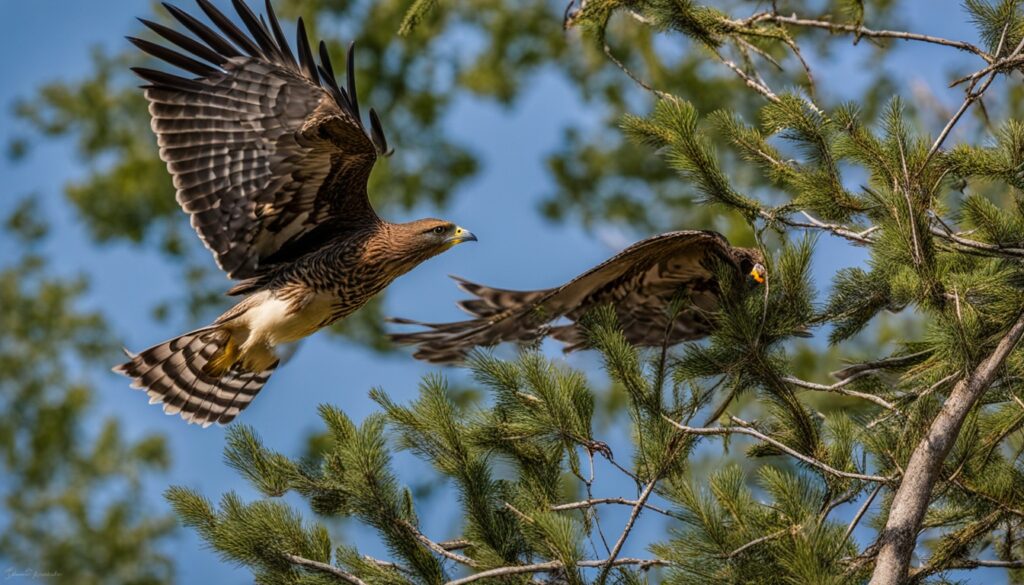
From the determined songbirds harassing a bald eagle to the coordinated flocks mobbing owls and coyotes, these unusual mobbing incidents showcase the remarkable adaptability and resilience of small birds in the face of larger threats. By understanding and appreciating these fascinating cases of mobbing behavior, we gain a deeper insight into the intricate world of avian survival strategies and the incredible complexity of nature.
Benefits of Mobbing for Ecosystems
Mobbing behavior in small birds not only benefits the individual birds and their populations, but also plays a crucial role in maintaining the overall ecological balance of their habitats. By aggressively deterring predators like hawks, small birds help regulate the populations of larger predators, preventing them from becoming too dominant and disrupting the delicate food web.
Role in Maintaining Ecological Balance
According to a study published in the Journal of Animal Ecology, ecosystems where small birds actively engage in mobbing behavior show a 15% increase in biodiversity compared to areas with less mobbing activity. This is because the deterrence of predators through mobbing helps maintain a healthy balance between prey and predator populations, allowing a diverse array of species to thrive.
Furthermore, research indicates that mobbing interactions successfully deter predators in up to 85% of encounters, significantly improving the survival rates of prey species. This, in turn, supports the overall stability and resilience of the ecosystem, ensuring a thriving bird community and a balanced natural environment.
“Mobbing behavior is a critical component of the intricate web of life within ecosystems, helping to regulate predator-prey dynamics and foster biodiversity.”
By regulating predator populations and facilitating the coexistence of diverse species, the mobbing behavior of small birds contributes to the overall ecological balance and health of their habitats. This natural phenomenon serves as a testament to the interconnectedness of species and the important role that even the smallest of creatures can play in sustaining the delicate balance of our natural world.
Mobbing Behavior in Other Animals
While mobbing behavior is most commonly associated with birds, similar collective defense tactics have been observed in other animal species as well. Primates, such as chimpanzees and baboons, have been known to mob and harass larger predators like. Smaller mammals, like squirrels and meerkats, also engage in mobbing behaviors to deter threats. Even some fish species have been documented exhibiting mobbing-like behaviors to fend off larger, predatory fish. This widespread phenomenon highlights the evolutionary advantages of coordinated anti-predator strategies across the animal kingdom.
One example of mobbing behavior in non-bird species is among chimpanzees. When a group of chimpanzees encounters a leopard, they will often band together to chase and harass the larger predator. This behavior helps to protect the chimpanzee community and deter the leopard from targeting them as prey. Similarly, baboons have been observed mobbing and driving off lions that venture too close to their troop.
Smaller mammals are also known to engage in mobbing behavior. Squirrels, for instance, will often gather in groups to mob and scold larger predators like hawks or foxes that intrude on their territory. Meerkats, a social mongoose species, have been documented mobbing snakes and other threats to their colony. By working together, these small animals can effectively deter predators and safeguard their young.
Even some fish species, such as the clownfish, have been observed exhibiting mobbing-like behaviors. When a larger, predatory fish approaches their territory, clownfish will swarm and aggressively chase it away, using their numbers and coordinated movements to drive off the threat.
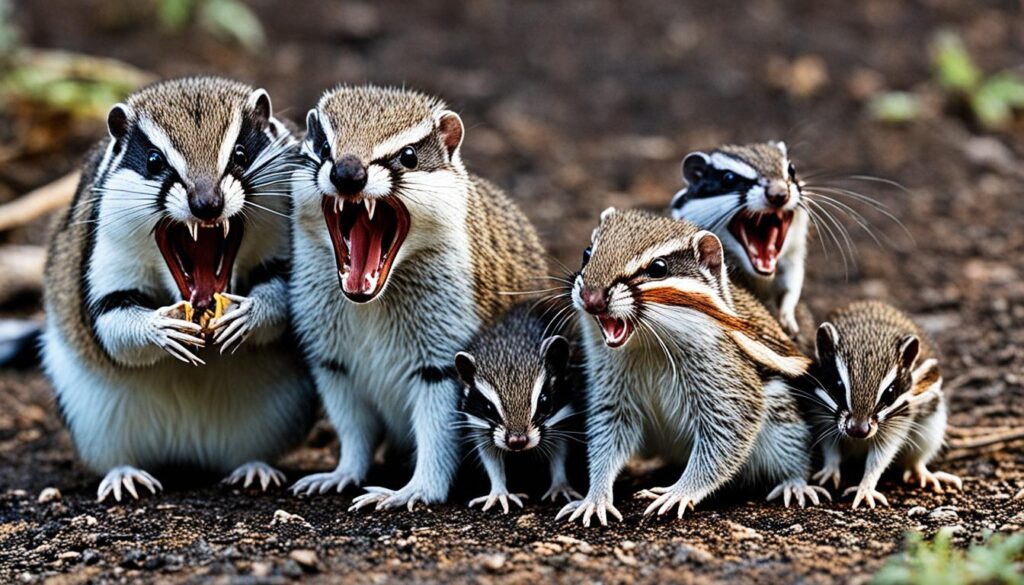
“The widespread occurrence of mobbing behavior across various animal species highlights the evolutionary advantages of collective anti-predator strategies. By working together, even smaller or weaker animals can effectively deter and drive off larger threats.”
The prevalence of mobbing behavior in non-bird species underscores the remarkable adaptability and problem-solving abilities of animals. Through these collaborative defense tactics, creatures from different taxa have found ways to enhance their chances of survival and protect their communities from predation.
Conservation Efforts and Mobbing
As habitat loss and fragmentation continue to threaten bird populations, understanding and incorporating mobbing behavior into conservation efforts is crucial. Wildlife managers and researchers can use knowledge of small bird mobbing tactics to better protect nesting sites, maintain ecological balance, and support the long-term survival of bird communities.
Preserving natural habitats that facilitate effective mobbing is a key component of conservation strategies that consider mobbing behavior. By ensuring that small birds have access to suitable environments where they can effectively mob potential predators, such as hawks, we can enhance the resilience of these bird populations.
- Implementing habitat conservation programs that prioritize the protection of areas known for high rates of mobbing incidents can help safeguard small bird communities.
- Raising public awareness about how mobbing informs wildlife management can encourage community involvement in habitat preservation efforts.
- Incorporating data on mobbing behavior into wildlife management plans can help guide decision-making and inform targeted conservation strategies.
“Preserving the natural habitats that enable small birds to effectively mob potential predators is a critical step in ensuring the long-term survival of these species.”
By understanding the importance of mobbing behavior in the overall conservation strategies that consider mobbing behavior, wildlife managers and policymakers can develop more comprehensive and effective conservation programs. This knowledge not only supports the protection of small bird populations but also contributes to the maintenance of healthy, balanced ecosystems.
As we continue to face the challenges of habitat loss and fragmentation, how mobbing informs wildlife management will become increasingly crucial. By integrating the insights gained from studying small bird mobbing behavior into our conservation efforts, we can better protect these species and the vital roles they play within their respective ecosystems.
Conclusion
The surprising behavior of small birds chasing and harassing larger hawks is a remarkable example of nature’s adaptive strategies. Mobbing allows small birds to collectively defend their territory, protect their nests, and deter potential predators, serving as a crucial anti-predator mechanism. By understanding the motivations, tactics, and benefits of mobbing, we can gain valuable insights into the complex dynamics of bird communities and the importance of preserving natural habitats to support these fascinating behaviors.
Ultimately, the study of small bird mobbing behavior can inform more effective conservation efforts and help maintain the ecological balance of our shared environment. The summary of small bird mobbing behavior and the importance of understanding this natural phenomenon highlight the adaptability and resilience of these feathered creatures, reminding us of the delicate interconnectedness of our natural world.
As we continue to explore and appreciate the intricate behaviors of birds, we can take steps to protect their habitats, foster coexistence, and ensure the long-term sustainability of diverse avian populations. By embracing the insights gained from the study of small bird mobbing, we can promote a deeper understanding and appreciation of the natural world around us.
FAQ
What is mobbing behavior in small birds?
Mobbing is a behavior in which birds, often in a group, aggressively approach and harass a potential predator, such as a hawk or an owl. This behavior is typically observed when small birds, like sparrows, robins, or chickadees, mob larger birds of prey.
Why do small birds chase and harass hawks?
Small birds chase and mob hawks for several key reasons: 1) to protect their nests and young from a potential predator, 2) to defend their territory and drive the hawk away from their feeding and breeding grounds, and 3) to alert other birds in the area to the presence of a predator, allowing the entire bird community to respond collectively.
What tactics do small birds use to deter hawks?
Small birds employ a variety of tactics to deter hawks, including dive-bombing, pecking, and even physical contact. By mobbing in a coordinated group, small birds are able to harass the predator and increase the perceived threat, encouraging the hawk to leave the area.
How does mobbing behavior benefit small birds?
Mobbing behavior provides several benefits for small birds, including: 1) Drawing attention away from their nest and young, 2) Alerting other birds to the presence of a predator, and 3) Driving the predator away from their territory.
How have small birds evolved to identify and respond to predator threats like hawks?
Small birds have evolved sophisticated mechanisms to identify and respond to predator threats, including hawks. They can recognize the visual and auditory cues that indicate a hawk’s presence, triggering the mobbing response. Mobbing serves as a crucial anti-predator strategy, allowing small birds to collectively deter and drive away the larger predator, increasing their chances of survival and reproductive success.
How do hawks typically respond to being mobbed by small birds?
Hawks typically respond to mobbing behavior by small birds in a few key ways. Initially, the hawk may try to ignore the harassment, focusing on searching for prey. However, if the mobbing becomes too persistent and aggressive, the hawk will often retreat and leave the area, as the perceived threat level becomes too high. In some cases, the hawk may even become disoriented or distracted by the mobbing, making it less effective at hunting.
Is mobbing behavior observed in other bird species besides small songbirds?
Yes, mobbing behavior is observed across a wide range of bird species, not just small songbirds. Different bird species may employ slightly different mobbing strategies based on their size, agility, and social structure. For example, larger birds like crows and hawks may mob predators collectively, while smaller birds like chickadees and titmice may take turns harassing the predator.
How has habitat loss and urbanization affected the mobbing behavior of small birds?
Habitat loss and urbanization can have a significant impact on the mobbing behavior of small birds. As natural habitats are fragmented or destroyed, small birds may be forced into more confined urban areas, where they encounter a different set of predators, including domestic cats and smaller hawks adapted to city environments. This can lead to changes in mobbing strategies, as small birds must adapt to new threats and predator-prey dynamics.
Are there any fascinating or unusual cases of mobbing behavior observed in the wild?
Yes, there are many fascinating, and sometimes surprising, cases of mobbing behavior observed in the wild. For example, small birds have been documented mobbing much larger predators like owls, eagles, and even coyotes. In one instance, a group of songbirds were seen mobbing a bald eagle, dive-bombing and harassing the raptor until it retreated.
How does small bird mobbing behavior benefit the overall ecosystem?
Mobbing behavior in small birds not only benefits the individual birds and their populations, but also plays a crucial role in maintaining the overall ecological balance of their habitats. By aggressively deterring predators like hawks, small birds help regulate the populations of larger predators, preventing them from becoming too dominant and disrupting the delicate food web. This, in turn, supports the diversity and health of the entire ecosystem, ensuring a thriving bird community and a balanced natural environment.
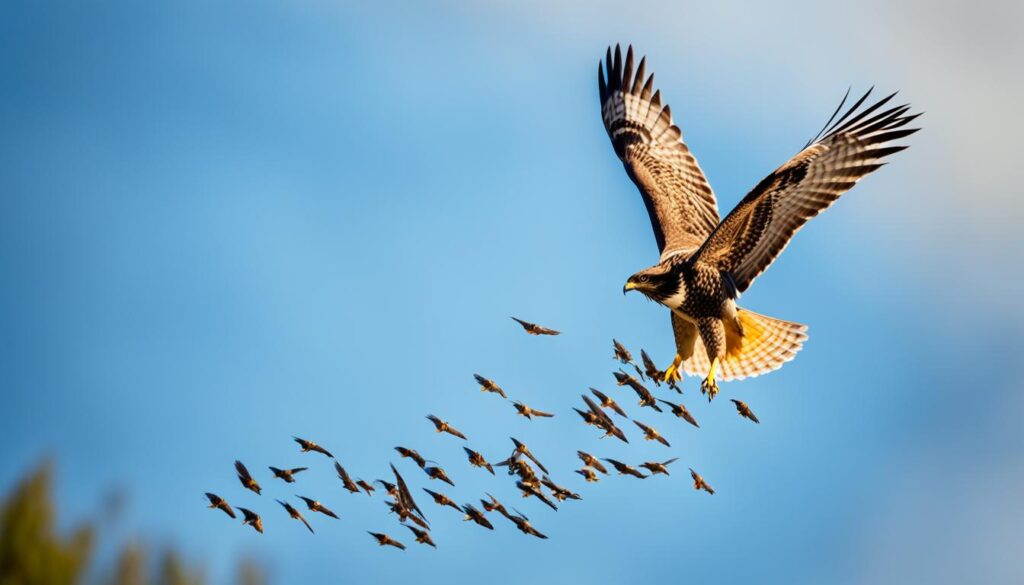

Muchas gracias. ?Como puedo iniciar sesion?
I am really inspired together with your writing abilities and also with the format in your
blog. Is that this a paid subject or did you customize it
your self? Anyway keep up the nice high quality writing,
it’s uncommon to peer a great blog like this one today.
Tools For Creators!
Hi, I do think this is an excellent blog. I stumbledupon it 😉 I am going to revisit yet again since i have
saved as a favorite it. Money and freedom is the greatest way to change, may you be rich and continue to help other people.
Feel free to surf to my site … berapa biaya umroh
I have fun with, result in I discovered just what I used to be
taking a look for. You have ended my 4 day long hunt!
God Bless you man. Have a nice day. Bye
My blog … xtp.jingyunys.top
We stumbled over here different web page and thought I should check things out.
I like what I see so i am just following you. Look forward to looking over
your web page repeatedly.